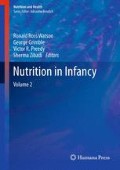Abstract
Diabetes mellitus is the most common metabolic disease of childhood and is characterised by a defect in the secretion or action of insulin. Deficiency of insulin at tissue level results in abnormalities in the metabolism of carbohydrate, protein and lipid. Diabetes is diagnosed on the basis of blood glucose criteria and the presence or absence of typical symptoms such as polyuria, polydipsia, and weight loss [1] (Table 16.1). In the absence of symptoms more than one blood glucose result is required in order to make a diagnosis.
Access this chapter
Tax calculation will be finalised at checkout
Purchases are for personal use only
References
World Health Organisation. Definition, diagnosis and classification of diabetes mellitus and its complications. Part 1: diagnosis and classification of diabetes mellitus. WHO/NCD/NCS/99.2. Geneva. Ref Type Report. 1999.
Craig ME, Hattersley A, Donaghue KC. Definition, epidemiology and classification of diabetes in children and adolescents. ISPAD clinical practice consensus guidelines 2009 compendium. Pediatr Diabetes. 2009;10 (Suppl12):3–12.
Patterson CC, Dahlquist GG, Gyurus E, Green A, Soltesz G, EURODIAB Study Group. Incidence trends for childhood type 1diabetes in Europe during 1998–2003 and predicted new cases 2003–20:a multicentre study. Lancet. 2009;373:2027–33.
Greeley SA, Tucker SE, Naylor RN, Bell GI, Philipson LH. Neonatal diabetes mellitus: a model for personalized medicine. Trends Endocrinol Metab. 2010;21:464–72.
Pinhas-Hamiel O, Zeitler P. The global spread of type 2 diabetes mellitus in children and adolescents. J Pediatr. 2005;146:693–700.
NICE Type 1 diabetes diagnosis and treatment of type 1 diabetes in children and young people, 2004 www.nice.org.uk/pdf/type1/diabetes. Accessed 13 Aug 2011.
Smart C, Aslander-van Vliet E, Waldron S. Nutritional management in children and adolescents with diabetes, ISPAD clinical practice consensus guidelines. Pediatr Diabetes. 2009;10 Suppl 12:100–17.
Department of Health. Dietary reference values for food energy and nutrients for the United Kingdom. Report of the panel on dietary reference values of the committee on medical aspects of food policy. Rep Health Soc Subj (Lond). 1991;41:1–20.
Franz MJ, Bantle JP, Beebe CA, et al. Evidence-based nutrition principles and recommendations for the treatment and prevention of diabetes and related complications. Technical review. Diabetes Care. 2002;25:148–98.
American Diabetes Association. Evidence based nutrition principles and recommendations in diabetes (position statement). Diabetes Care. 2003;26 Suppl 1:S51–61.
Department of Health. At least 5 a day. Strategies to increase vegetable and fruit consumption.1997. www.dh.gov.uk/en/Publicationsandstatistics/Publications/PublicationsPolicyAndGuidance/DH_4008049 .Accessed 12 Aug 2011.
Scientific Advisory Committee on Nutrition. Salt and health. London TSO 2003.
Fewtrell M, Wilson DC, Booth I, Lucas A. Six months of exclusive breast feeding: how good is the evidence? BMJ. 2010;342:c5955.
Silverstein J, Klingensmith K, Copeland L, Plotnick L, Kauffman F, Laffel L, Deeb L, Grey M, Anderson B, Holzmeister LA, Clark W. Care of children and adolescents with type 1 diabetes: a statement of the American Diabetes Association. Diabetes Care. 2005;28:186–212.
Gonder-Fredrick LA, Zrebiec JF, Bauchowitz AV, Ritteband LM, Magee JC, Cox DJ, Clarke WL. Cognitive function is disrupted by both hypo and hyperglycemia in school-aged children with type 1 diabetes: a field study. Diabetes Care. 2009;32:1001–6.
Author information
Authors and Affiliations
Corresponding author
Editor information
Editors and Affiliations
Rights and permissions
Copyright information
© 2013 Springer Science+Business Media New York
About this chapter
Cite this chapter
Ayling, R.M. (2013). Nutritional Management of Diabetes Mellitus in Infants and Children. In: Watson, R., Grimble, G., Preedy, V., Zibadi, S. (eds) Nutrition in Infancy. Nutrition and Health. Humana Press, Totowa, NJ. https://doi.org/10.1007/978-1-62703-254-4_16
Download citation
DOI: https://doi.org/10.1007/978-1-62703-254-4_16
Published:
Publisher Name: Humana Press, Totowa, NJ
Print ISBN: 978-1-62703-253-7
Online ISBN: 978-1-62703-254-4
eBook Packages: MedicineMedicine (R0)

